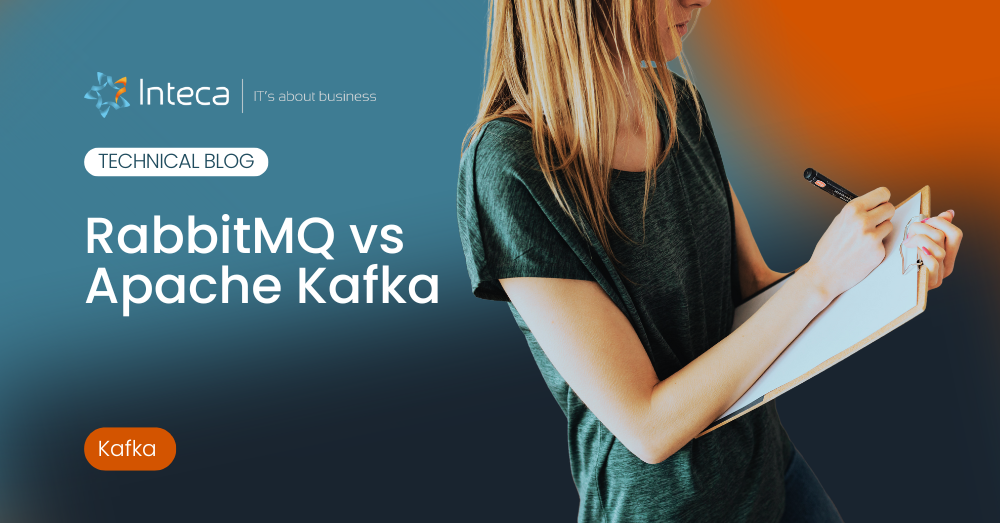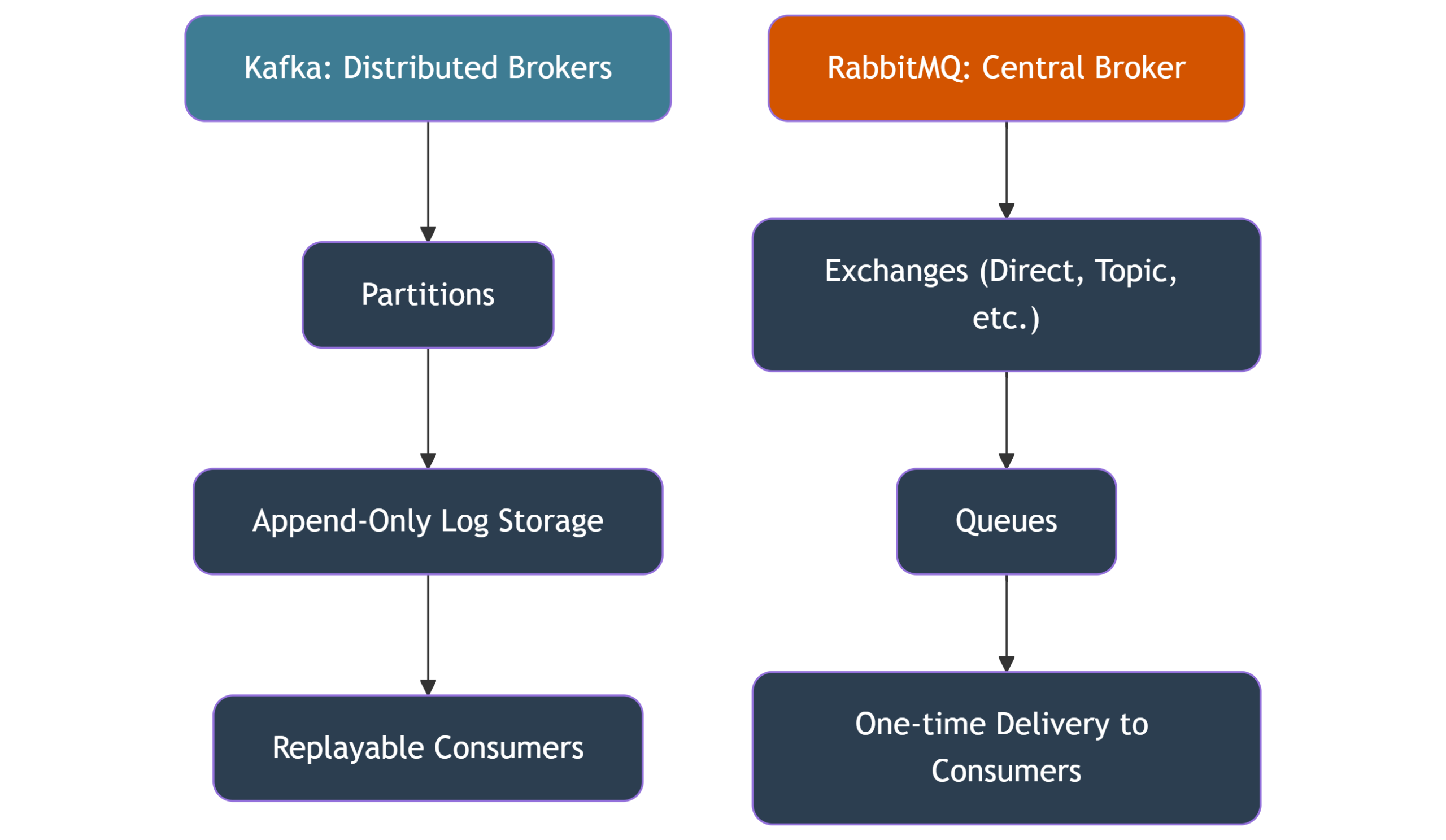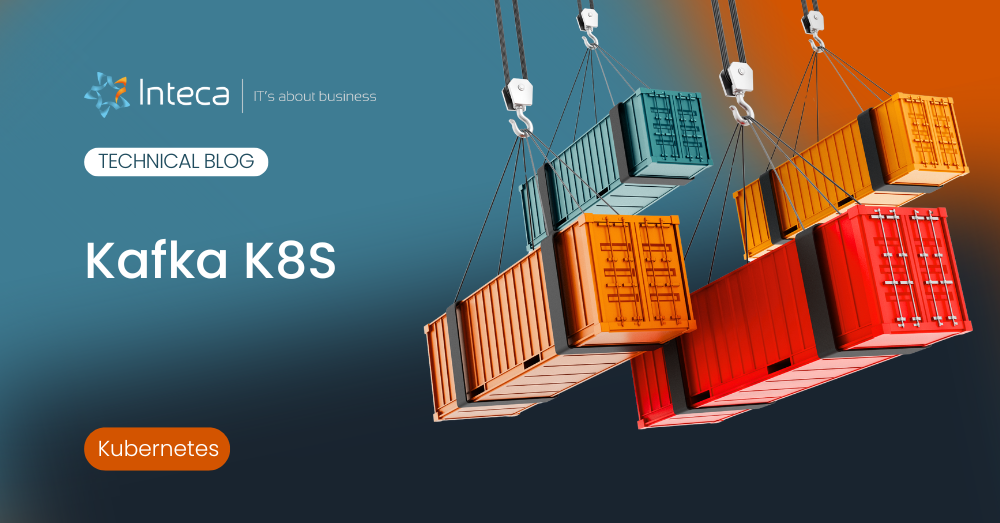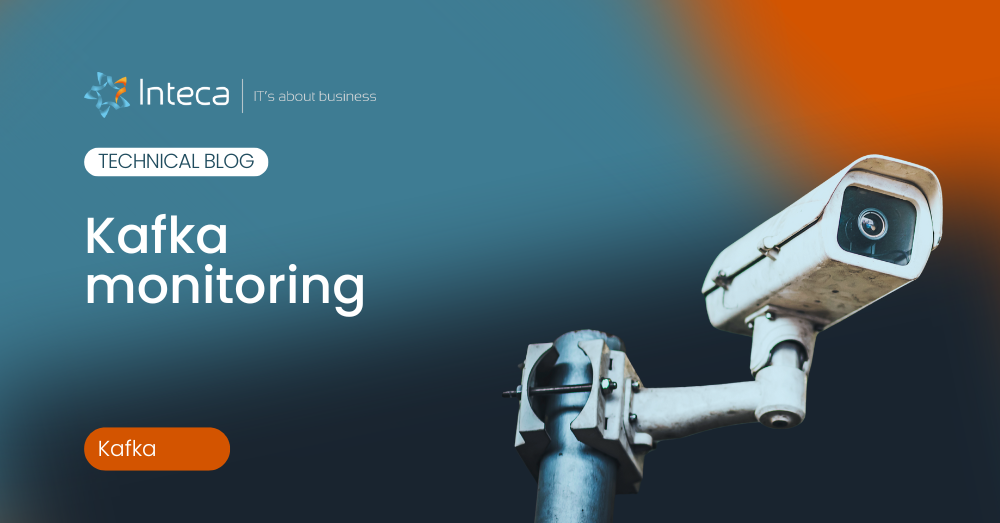Choosing between Apache Kafka and RabbitMQ is a high-stakes architectural decision for teams building real-time, event-driven systems. While both are messaging platforms, their core design philosophies differ greatly—Kafka is optimized for high-throughput event streaming and persistent logs, while RabbitMQ focuses on flexible routing, guaranteed delivery, and traditional message queuing.
This guide compares Kafka and RabbitMQ across architecture, performance, delivery semantics, stream processing, use cases, and more—so you can select the right platform based on your business needs, scalability targets, and development model.
What is Apache Kafka?
Apache Kafka is a distributed event streaming platform designed to handle massive volumes of real-time data. It follows a log-based architecture, where events are stored durably in partitions and can be re-read by consumers at any point. Kafka is ideal for real-time data pipelines, event sourcing, and analytics.
- Kafka is highly scalable, fault-tolerant, and supports replayable event streams
- Built-in support for Kafka Connect, Kafka Streams, and integration with tools like Apache Flink and ksqlDB
- Supported in Kubernetes via Strimzi for declarative, cloud-native deployments
- Frequently used for decoupling services and centralizing event data
What is RabbitMQ?
RabbitMQ is a message broker that supports a variety of messaging protocols, most notably AMQP 0-9-1. It’s built for flexible message routing, supporting direct, fanout, topic, and header exchanges.
- RabbitMQ excels in task queues, RPC messaging, and IoT protocols (via MQTT plugins), but when comparing RabbitMQ vs Apache Kafka, Kafka’s streaming capabilities stand out.
- Newer RabbitMQ Streams brings log-based consumption, though it’s still maturing
- Supports plugins for STOMP, MQTT, WebSockets, and more
- Designed for low-latency, reliable message delivery, and protocol interoperability
Kafka vs RabbitMQ: architectural comparison
| Feature | Apache Kafka | RabbitMQ |
|---|---|---|
| Design Model | Distributed, partitioned, append-only log | Centralized broker using queues and exchanges |
| Message Replay | Yes, from any offset | No, messages removed after acknowledgment in RabbitMQ, while Kafka retains messages for a configurable duration. |
| Persistence | Durable storage by default | Durable queues optional; removed post-consumption |
| Routing | Partition-based (simple, scalable) | Flexible exchange types: direct, topic, fanout, headers |
| Protocol Support | Native Kafka protocol | AMQP, MQTT, STOMP, WebSockets (via plugins) |
| Stream Processing | Kafka Streams, Flink, ksqlDB | Basic stream API (new), not designed for analytics |
| Throughput & Scale | Extremely high (trillions of events/day) | Lower, scales via federation/clustering |
| Latency | Milliseconds (event stream optimized) | Microseconds–low milliseconds (good for RPC) |
| Replayability | Full replay support | Not supported |
When should you use Kafka? – Kafka use case
When considering RabbitMQ vs Kafka, it’s essential to understand their specific use cases. RabbitMQ is ideal for traditional messaging applications requiring low latency and RabbitMQ supports complex routing. In contrast, Kafka can be used for high-throughput scenarios, handling millions of messages per second with a distributed message broker.
For real-time data processing, running Kafka is often preferable. Its Kafka topics allow for efficient organization of data streams. Understanding the differences between RabbitMQ and Apache Kafka is crucial for selecting the right tool for your project. If you need a Kafka cluster, you’re looking at a robust messaging system that can scale.
In summary, when deciding between RabbitMQ or Kafka, consider the nature of your application. If your application requires complex routing and a more traditional approach, get started with RabbitMQ. However, for high-throughput data streams, using RabbitMQ and Kafka can be an effective alternative, leveraging the strengths of both.
Best fit for:
- Real-time analytics (e.g., clickstreams, telemetry, fraud detection)
- Event-driven microservices with high throughput
- Event sourcing and log-based system designs
- Distributed logging and audit trails
- High-scale ingestion for AI/ML pipelines
When should you use RabbitMQ? – RabbitMQ use case
While Kafka excels in high-throughput real-time data streaming , RabbitMQ is ideal for use cases requiring flexible task queues and RPC mechanisms. Its flexible routing and acknowledgment mechanisms make it a strong choice for these scenarios. RabbitMQ also serves well as a microservice event backbone, especially when complex routing is necessary to direct messages to the appropriate services. RabbitMQ supports a variety of messaging protocols, enhancing its versatility in different environments, but it is primarily recognized as a message bus, unlike Kafka which is a streaming platform. For applications needing message queue functionalities and intricate routing capabilities, RabbitMQ presents a compelling solution. Understanding the differences between RabbitMQ and Kafka helps in making an informed decision based on specific application needs. If complex routing is a priority, use RabbitMQ.
Best fit for:
- Task distribution and job queues
- Message routing logic via AMQP or MQTT
- Lightweight microservice communication
- RPC-style workflows
- IoT systems that rely on protocol diversity
Stream processing capabilities
Apache Kafka
- Native Kafka Streams for in-app processing (joins, aggregations, stateful ops)
- Integration with Apache Flink for scalable stream analytics
- ksqlDB provides SQL-style querying on real-time streams
- Used for real-time fraud detection, user behavior modeling, and ETL pipelines
RabbitMQ messaging system
- New Streams API adds log-style streaming to queues
- No native stream processing or built-in analytics framework is a limitation for RabbitMQ, whereas Kafka provides robust streaming features.
- Suitable for basic event forwarding, not analytical workloads
Message delivery guarantees
| Guarantee Type | Kafka | RabbitMQ |
|---|---|---|
| At-least-once delivery is a guarantee type that Kafka consumers can rely on for message processing. | Default | Default (via ACKs) |
| Exactly-once | Kafka Streams + Idempotency | Not natively supported |
| Transactional | Supported via Kafka transactions | Supported via publisher confirms |
Deployment & operations
- Kafka often requires more operational overhead:
- Brokers, Zookeeper (or KRaft), storage optimization, partition tuning
- Managed services like Confluent Cloud or Amazon MSK reduce this burden
- RabbitMQ is easier to get started with:
- Simpler to deploy on VMs or Kubernetes
- Excellent management UI and plugin system
Security & monitoring
Apache Kafka
- TLS, SASL/SSL, ACLs, RBAC
- Monitoring with Prometheus, Grafana, and tools like Redpanda Console
- Strong integration with Kubernetes (Strimzi CRDs)
RabbitMQ
- TLS, user/password auth, fine-grained permissions
- Native UI and HTTP API for monitoring
- Supports Prometheus exporters
Final Verdict: RabbitMQ vs Apache Kafka?
There’s no universal “best” platform—only one that fits your architectural needs:
Choose Apache Kafka if you need:
- High-throughput, durable, replayable data streams
- Stream processing and analytics
- Central event bus for microservices
- Long-term log storage with decoupled consumers is a feature that Kafka provides, allowing for flexible data access.
Choose RabbitMQ if you need:
- Complex message routing
- Protocol flexibility (AMQP, MQTT, etc.)
- Lightweight or real-time RPC-style communication
- Easy deployment and management for smaller workloads






